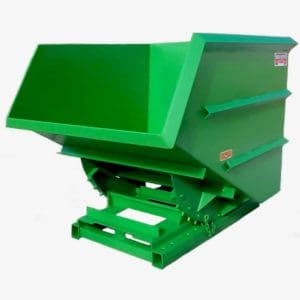When companies look to upgrade their bulk material handling processes and capabilities, they invariably come face-to-face with choosing between an industrial-strength storage hopper or a bin. The goal is to have a safe, secure, and reliable means of storing, moving, transporting, and unloading end-of-shift or end-of-day scrap metal, trash, or refuse. One solution is safe and easy to use while the other can often put employees at risk of injury.
Keep reading to learn more.
What Is the Difference Between a Hopper & Bin?
It’s not uncommon to hear people use hoppers and bins interchangeably. However, there are some essential differences between the two in terms of what they store, how much they can hold, and how the material is transported and unloaded.
Bin
The word “bin” is a more generic term that can include something as simple as a residential garbage bin or a small bin to hold raw materials in flow racks and carts, all the way to industrial-sized, heavy-duty storage containers.
Storage Hopper
A storage hopper is a specialized type of bin; its design and construction has been optimized to ensure it can safely unload and withstand the heaviest scrap materials.
Which One Is Better?
As previously mentioned, storage hoppers are specially designed for use with heavy, bulk materials. For most industrial applications, a self-dumping storage hopper will be the safer and more efficient option.
The Value of Self-Dumping Hoppers

Think about the time and effort it takes your operators, technicians, and employees to transport and unload industrial bins. Sometimes, it takes two to three employees to lift, move, and empty these bins. Even the strongest, most durable industrial containers can often be challenging and even dangerous to manipulate. Their circular, rectangular, or square base often sits flush with the floor, which means that employees often must tilt the bin for it to be loaded onto a forklift. That’s a dangerous position for employees to be in.
With self-dumping hoppers, the weight of the material inside the hopper does the work. A single operator in a forklift can safely pick up, move, and unload the hopper without ever leaving the forklift or being put in a position where an injury might occur.
However, before you invest in a self-dumping hopper, you must understand that some hoppers are designed for certain applications. Always research first before you purchase your hopper, and be sure you know what your load and volume requirements are, as well as any space restrictions.
Still Have Questions? Contact Roura Today!
Founded in the 1920s, Roura specializes in manufacturing custom self-dumping hoppers for a wide array of industrial applications. If you need help selecting the right hopper for your workplace, or just have general questions about self-dumping hoppers, please contact us today.